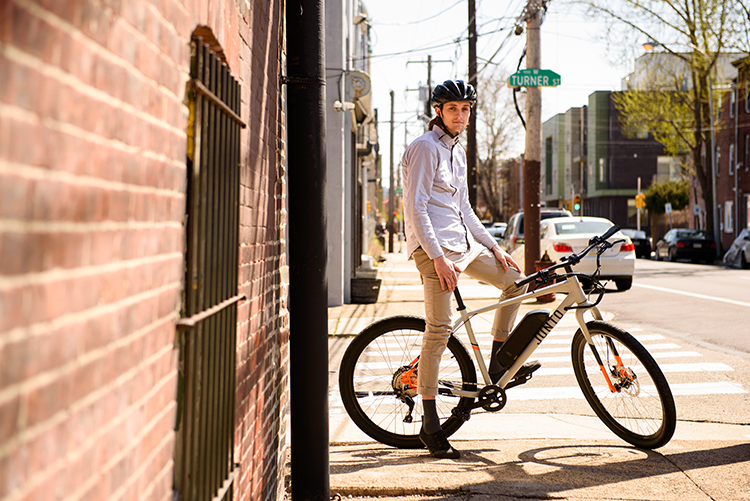The future of bike travel will be… motorized?
By Randy Lobasso
Brian Powell likes to say electric bicycles just sort of happened to him.
“I was at the beach. I was riding [my bicycle] from Cape May to Ocean City, I was out on a Saturday and it was beautiful,” the Chestnut Hill resident says. “And I was humping along and some big old guy came flying past me on an e-bike.”
Powell, 55, whistled at the guy to catch his attention. “And I said, ‘What… is this?’ Because he was a big guy, you know? And he flew by me.”
At that time—August 2016—Powell had only vaguely heard about e-bikes. But, fascinated by what he’d just witnessed, he asked if he could take a ride.
“I came back and I had this giant grin on my face and… I was obsessed by it.”
Fourteen months later, Powell was the president of Junto, a Philly based direct-to-consumer e-bike company. It was his fifth startup business.
In the fiscal year ending in July 2017, e-bike sales grew 95 percent over the previous year, according to the NPD Group, a market research company. NPD also found e-bike sales have tripled over the past three years in the U.S.
While 1.5 million electric cars were sold throughout last year, 35 million e-bikes were purchased around the world, reported The New York Times in November. More than 150 million e-bikes have been sold since 2003—mostly in China—and some bike-sharing companies, such as JUMP in Washington, D.C., now offer e-assist bicycles.
The biggest hurdle, though? Lots of Americans are still in the place where Powell was in 2016: They don’t know what e-bikes are.
‘Imagine an escalator’
E-bikes are not motorcycles. Not really, anyway. Rather, they’re battery-assisted pedal-cycles, giving the rider an advantage when wrestling up hills and over long distances. E-bikes have the ability to get you to your destination without breaking a sweat, but while still getting some exercise.
“Imagine an escalator,” says Powell. “I mean, if you’re walking up the steps, you get there in a certain amount of time. If you’re walking up the escalator, you’re going to get there twice as fast.”
Most e-bikes sold on the market provide what’s called a pedal-assist; if you’re providing pressure to the pedals, the bike is, too. If you’re not pedaling, the bike’s not working for you.
This technology has given people with long commutes, and those who feel they’re too old or out of shape for pedaling uphill, a newfound appreciation and usage of two-wheeled glory.
Junto bikes offer a pedal-assist for riders and, like most e-bikes, a display on the handlebar.
Given the large battery component, which usually allows the rider to go 30 to 40 miles on a charge, e-bikes are substantially heavier than your typical bicycle, weighing about 50 to 70 pounds.
Pennsylvania law has caught up to e-bikes. As long as it does not have a pedal-assist option of more than 20 miles per hour (which is referred to as a “Class 1” e-bike), it’s considered a bicycle and is regulated about as much as a Huffy. Class 2 and Class 3 e-bikes exist, too, and have caused controversy due to their ability to go, well, really fast.
Like anything in the bicycle industry, prices vary depending on quality. You can pay as little as around $500 and as much as, well, $15,000. Compare it to a “$100 OBO” beater bike you’re hawking off Craigslist, and it all sounds like a pretty expensive endeavor. Compare it to a $100,000 Tesla electric car, and it’s practically free.
Powell began commuting 13 miles to his Fishtown office after starting his e-bike company. “The experience of being at eye-level with people, of seeing them, being in your community,” he says, “there’s something really mystic about it that I didn’t know.”
‘More people are seeking a car-free lifestyle’
That feeling is something Meenal Raval and Afshin Kaighobady have held onto for a while; they’ve been betting on e-bikes for nearly a decade. Since opening Philly Electric Wheels in 2009, the couple have moved their shop twice—once from Mt. Airy Village at Carpenter and Greene streets to Germantown Avenue, then to East Mount Airy, across from the Sedgwick Regional Rail Station.
“When we started, it was hard to sell a $2,000 e-bike, and had to keep a $500 option on the floor. Now, this price tag seems to be more acceptable,” says Raval. “More people are seeking a car-free lifestyle, and as a result, have much less hesitation when deciding between a second car or an e-bike.”
Dena Driscoll of South Philly, who is co-chair of the urbanist political action committee 5th Square, has been using an e-bike since 2013.
“When I purchased the bike, I was 36 weeks pregnant with my youngest child; I was already riding with my oldest, who was 2 at the time,” she says. “I knew my kids would just grow bigger, and since Philadelphia’s bicycle infrastructure isn’t built for all ages to ride safely, I knew I would have to tote them on my bike even as they grew older… I was able to pedal myself and my son while pregnant in Manayunk up and down the hills until I gave birth at 41 weeks… Five years later, I am so glad I purchased a bike with assist.”
Raval says e-bikes expand the pool of cyclists to people who would otherwise rely on cars or public transportation.
“Think about a restaurant worker, working till late into the night, returning home when the streets are empty. An e-bike offers an opportune way to get home fast, without waiting for the bus,” she says, noting an elderly woman in South Philly can be assisted just as easily with an e-bike that “serves her daily needs, that involve errands, some shopping and doctor visits within a 2-to-3-mile radius.”
But there are still voices out there—millions of them—who say e-bikes are motorcycles and need to be regulated as such.
‘E-bikes are too often a danger’
Since their introduction, e-bikes have been shunned by a large population, and larger voice, within the bicycling community. Many shops in the region, including Frankinstien Bike Worx on Spruce Street in Center City, refuse to serve customers wielding electric bicycles.
Concerns about motorized bicycles on trails have been voiced at national bicycling summits in recent years, and New York City even experienced a crackdown on e-bikes.
Some e-bikes are equipped with throttles that bring the bike above 20 miles per hour, which has led to some parts of the country—20 states currently, according to research from PeopleForBikes—to regulate the vehicles the same way as mopeds, which often requires that riders register the bikes with their city or state.
In October 2017, New York City tried to ban e-bikes, responding to safety complaints from residents. The problem: E-bikes were going too fast. Many of these throttle-equipped vehicles were able to travel well over 30 miles per hour without forcing the cyclist to pedal, effectively making them motorcycles. Mayor Bill de Blasio and the NYPD stepped up enforcement, declaring it a Vision Zero issue.
“E-bikes are too often a danger on the city’s streets and sidewalks,” said NYPD Commissioner James P. O’Neill. “They’re illegal to operate here, but it seems like you can spot them everywhere—and that’s where our increased enforcement comes in.
After transportation and immigrants’ rights activists took their case to City Hall, Mayor de Blasio reversed course, declaring pedal-assist bicycles legal in the city, but continuing to outlaw throttle-equipped e-bikes that can travel over 20 miles per hour.
The dangers posed by e-bike riders, like regular cyclists, are largely anecdotal. Many residents in New York City believed those traveling on e-bikes were going too fast, yet there was little evidence to suggest those riding e-bikes were doing
so recklessly.
Philadelphia has not seen that sort of backlash, though it’s not too hard to imagine. Bicycles and their riders seem to invoke a certain negative emotional response among Philadelphia residents, and an e-bikelash season could be just around the corner.
‘People are even ditching Uber’
A Center City District report distributed in early 2018 found that Philadelphia’s traffic is at its worst in decades. From 2013 to 2017, vehicular travel times increased by 10 percent, while bus travel times increased by 25 percent (bicycle and pedestrian travel times did not change much). The report details the causes of congestion, contextualized by the rapidly changing social and physical nature of Center City, before offering suggestions for how to mitigate the growing problem.
It’s easy to see that with the introduction of ride-hailing apps and services, such as Uber and Lyft, congestion has become worse.
CCD introduced several ideas for cutting congestion, such as traffic enforcement by unarmed civilians, the elimination of on-street parking during business hours to create loading zones for deliveries, and designated pickup and drop-off zones for taxis and transportation network companies.
And that all may work. But for many, it’ll be too little, too late. “We don’t think of [Junto] as competition for bicycles,” notes Powell. “Our focus is on cars. Get cars off the road.”
Raval isn’t as convinced that e-bikes will replace cars—at least not until Philadelphia creates safer spaces for cyclists—though she has hope that e-bikes can soon become a regular part of city life.
“Given the inadequate cycling infrastructure in our region, I don’t know that an e-bike will let everyone completely disassociate from a car. Certainly, they’re ideal for a one-car family, or in conjunction with a car-sharing option,” she says. “But an e-bike empowers people to use a bike in a more utilitarian way, such as grocery shopping, and multimodal transportation. Every day we hear stories of how e-bikes are being integrated with a bus or train ride, without worrying about parking the car. People are even ditching Uber over e-bikes.”









